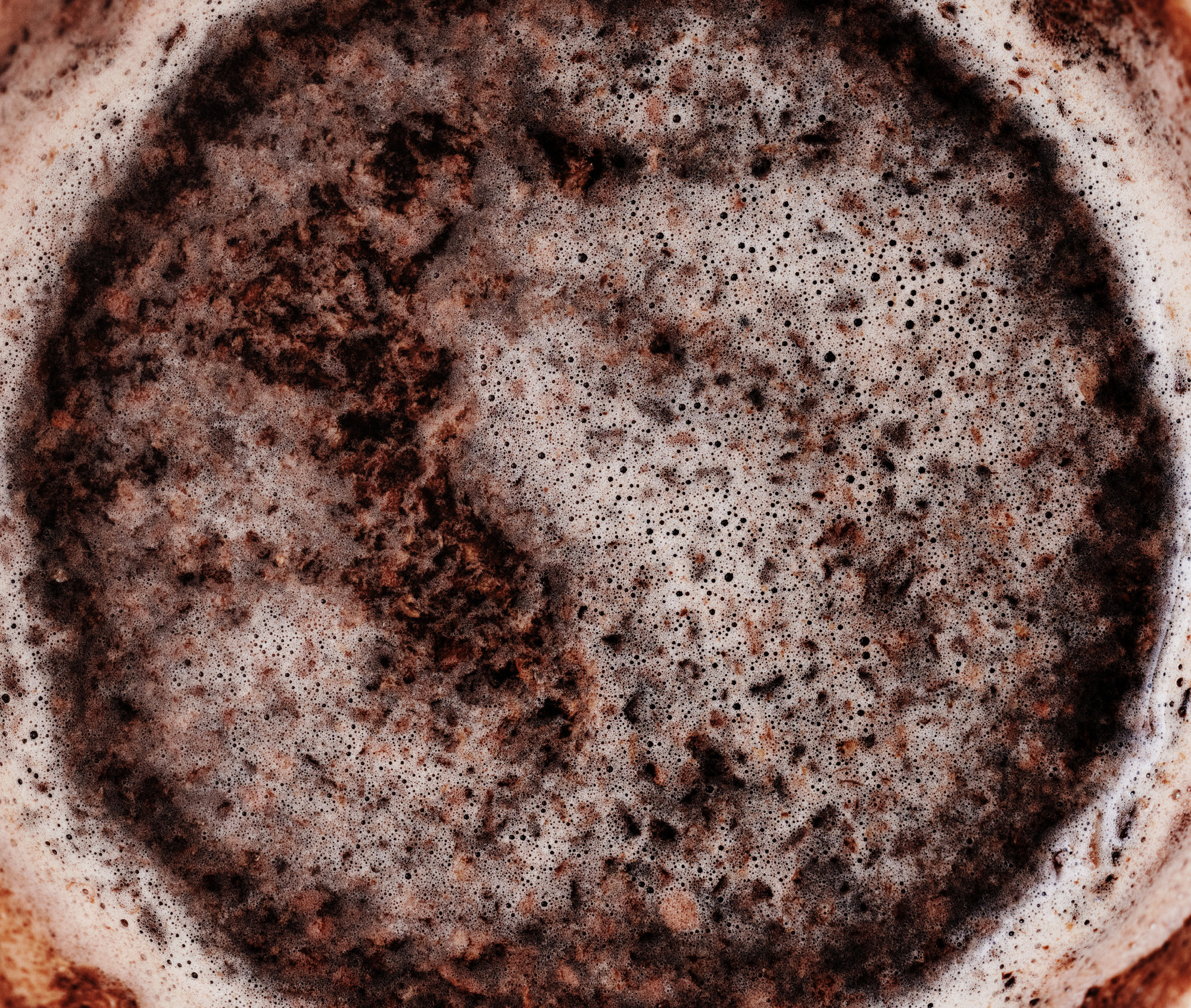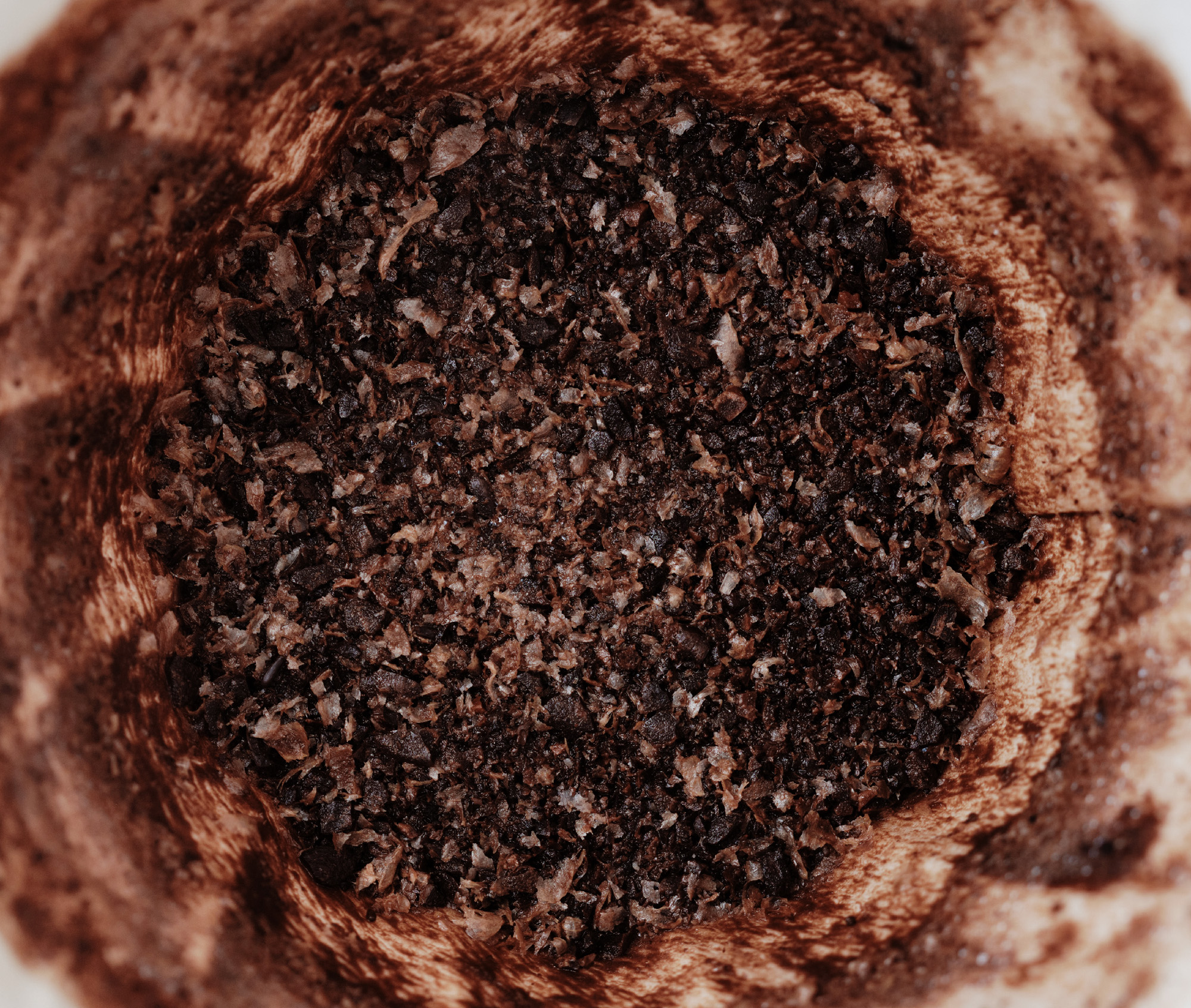Is it really essential for pour-over? What does it even do?
The Rao Spin is a technique in which the barista swirls the filter cone during brewing, to make the خليط القهوة spin. It’s named for Scott Rao, who popularised — but did not invent — the technique.1 It’s thought to increase extraction, reduce channeling and make brews more consistent. But how does it have this effect? And is it really better than other forms of agitation, such as stirring or aggressive pouring?
What’s So Great About It?
According to Rao, the main benefit is that it “minimizes channeling during the final drawdown and creates a flat spent bed every brew.” The flat bed is easy to see, a consequence of gravity settling the bed out evenly after swirling fluidises it. This means there are no ‘shortcuts’ for the brewing water to take via dips in the coffee bed, eliminating one source of uneven extraction.
Left: V60 brew after a spin, right: coffee bed after draw down.
The reduction in channeling is harder to see directly, since not all channels are visible. However, it can be inferred from the effect it has on extraction. At one cafe we interviewed, side by side testing showed that adding the swirl to their pour over technique didn’t significantly increase extraction, suggesting that the amount of agitation added by swirling wasn’t significant in this case. However, when comparing the results from dialling in over several months, the average extraction chosen by baristas was a full percentage point higher — suggesting that the technique raised the extraction ceiling significantly. Raising the extraction ceiling is a strong indicator that the swirl reduced channeling and made extraction more even.
Why Is It Better Than Stirring or Pouring?
Any form of agitation can be beneficial to filter brewing, by promoting increased — and more even — extraction. Adding agitation allows a coarser grind to be used to achieve the same level of extraction. Grinding more coarsely produces a more uniform particle size distribution with fewer الطحن الناعم, which is beneficial to filter brewing.
Agitation also allows the ماء التخمير to contact each coffee particle more evenly According to the SCA Coffee Brewing Handbook, “for uniform wetting and extraction…the brewing water must lift and separate each particle” (TR Lingle, 1996). This can be achieved with the flow of water alone — for example, this is the main source of agitation in batch brewers. Later on in the brew, however, the greater depth of water in the slurry dampens the flow, making this type of agitation less effective.
Getting agitation later in the brew, therefore, requires some sort of mechanical agitation — swirling or stirring. As a trainer, I find it easier to get baristas to be consistent with swirling than with stirring. It’s a simple, repeatable motion, and it’s easy to control how fast the swirl is, because the swirl of the خليط القهوة has a certain resonant frequency, which guides the speed of the swirl. Baristas are familiar with this feeling from swirling jugs of milk — swirl too fast or too slowly, and the foam will not mix properly into the milk. Swirling also equally agitates the whole coffee bed simultaneously, whereas it’s possible to inadvertently leave some parts of the bed undisturbed when stirring.
وفي a joint blog post with Rao, Jonathan Gagne proposes another possible reason that the swirl is so effective. He suggests that the centrifugal force acting on the brewing water during the spin pushes water out of its established paths, forcing it to wet previously drier areas of the coffee bed, and thereby breaking up channels.
What’s the Downside?
Swirling the خليط القهوة too much, however, seems to clog up the filter paper, choking the flow during drawdown. If the flow is too slow, this leads to microchanneling — channels too small to see, but still detectable by the astringent taste they give to the brew. This means the amount of swirling has to be carefully controlled — enough to break up the channels formed by uneven wetting, but not so much that it induces clogging and creates microchannels.
In his منشور المدونة, Gagne suggests that the clogging is due to centrifugal forces acting more strongly on larger particles than they do on الطحن الناعم. This would push the larger particles to the sides of the brewer, giving the الطحن الناعم an opportunity to settle to the bottom, he says. However, excessive stirring can also clog the filter paper. It’s possible that rather than centrifugal force being the culprit, what’s happening is some form of the Brazil-nut effect, in which random movements allow larger particles to ‘float’ to the surface, and the الطحن الناعم to sink.
Interestingly, a quick experiment suggests that the spin actually increases the flow through the top part of the filter paper, even while the bottom part of the bed is choking. We applied a thin layer of silicone to the top part of the filter paper to block the flow through the pores in the paper that were above the coffee bed. The silicone was applied to the outside of the paper.
![]() The inside of a creped 02 filter paper. The area outside the circle has had silicone injected into it.
The inside of a creped 02 filter paper. The area outside the circle has had silicone injected into it.
In a normal filter paper, the brews took a similar amount of time, with or without the Spin. But with the silicone applied, the Spin resulted in the brew choking. This could mean that in a normal brew, the effect of the الطحن الناعم sinking to the bottom is offset by increased flow through the top of the filter paper, perhaps as a result of the الطحن الناعم being washed off the sides of the filter paper and onto the surface of the coffee bed.
| Normal | Silicone | |
| No Spin | 260.5 | 321 |
| Spin | 219.5 | 493 |
Comparing the average total brew time (in seconds) of different V60 pour-overs on a ratio of 20:330g; with and without silicone blocking the top half of the filter paper. The Spin results in a much slower drawdown time, but only when the top half of the filter paper is blocked.
Whatever the cause of clogging in filter brews is, swirling and stirring both share this disadvantage. Swirling, however, seems to result in tastier brews than stirring, and is easier to repeat consistently — so we highly recommend incorporating it into your brewing routine.
1. The Origins of the Rao Spin – The Rao Spin as we now know it is famously not named after its probable inventor. In 2016, Scott Rao wrote that he “had never seen or heard of this method” until he was shown it by Italian Brewers Cup champion Alessandro Galtieri the previous year. Rao was tickled to learn that Galtieri called the technique the ‘Rao Spin’, saying “It’s so good, I wish I had invented it”.
Before 2016, references to the ‘Rao Spin’ mostly referred to a different technique — using an aggressive, circular pour to induce agitation, causing the surface of the خليط القهوة to spin. During the early 2010s, baristas — in London at least — were calling the technique of swirling the filter cone the ‘Hoff Swirl’, after it was popularised by James Hoffmann, but the technique may be even older than that. James Bailey, inaugural Coffee Masters champion, remembers showing Hoffmann the technique on the Prufrock brew bar — so perhaps we should be calling it the Bailey Twirl?






Thanks so much for this article.
I’ve been questioning why my brew time slows down when I do a swirl my Hario V60. But this article perfectly answers my question now! I’ve been swirling too fast to the point where the larger particles stick to walls on my filter paper, making the finer particles settle at the bottom.
I have a question: does roast profile affect brew time/drawdown time?
I feel like when I use a light roast for my Hario V60, the brew time is usually around 3mins. But when I use a dark roast, I find that my brew time is around 4mins.
Hi Parinhemtanon, Roast profile will certainly affect how many fines end up in the mix. Generally darker roasts are more brittle and will produce more fines than light roasts, so that may explain why your darker roast brews take longer to draw down, i.e., more fine particles will be available to block the pores in the filter paper. BH